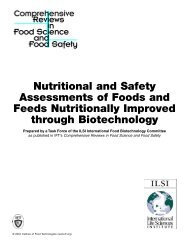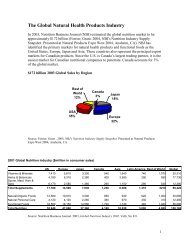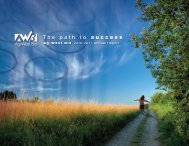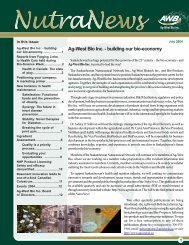Beyond Borders: Global biotechnology report 2010
Beyond Borders: Global biotechnology report 2010
Beyond Borders: Global biotechnology report 2010
You also want an ePaper? Increase the reach of your titles
YUMPU automatically turns print PDFs into web optimized ePapers that Google loves.
Perspectives for the new normal<br />
Focus and leverage<br />
Sangamo BioSciences was founded in 1995, a time when biotech<br />
funding was very scarce. But with focus and a business model<br />
that leverages existing activities and assets, our company thrived<br />
through the depths of this challenging period — and beyond.<br />
Validation without dilution<br />
How were we able to do this? In a difficult funding<br />
environment, we focused early on raising non-dilutive<br />
financing and validating our technology for potential investors.<br />
Soon after our founding, for instance, we obtained a US$2<br />
million Advanced Technology Program grant. This investment<br />
was non-dilutive, had no strings attached and — since it came<br />
from a very competitive program — was highly validating. The<br />
money could be applied to develop our core technology and,<br />
unlike our Small Business Innovation Research (SBIR) grants,<br />
was a material amount. In 1997, we did a Series B financing<br />
with two high-profile, experienced investors — Lombard Odier<br />
and JAFCO — which provided further validation.<br />
Over the next couple of years, we entered more than<br />
a dozen research tools/functional genomics deals with<br />
pharma companies. These were very small, often unfunded,<br />
transactions. They involved no intellectual property (IP) transfer.<br />
We simply used our zinc finger DNA-binding protein (ZFP)<br />
technology to create unique reagents for our partners’ needs.<br />
But since these were deals with big pharma partners, they were<br />
validating for investors.<br />
In late 1999, soon after our US$9 million Series C round, the<br />
markets turned bullish for biotech stocks. We announced our<br />
first therapeutics partnership, with Edwards Lifesciences, at<br />
the Hambrecht & Quist Healthcare Conference in January<br />
2000. Boosted by this validating partnership and overall market<br />
sentiment, we successfully raised US$52.5 million in our April<br />
2000 IPO (10 years ago!).<br />
Focus and leverage<br />
We monetized our core technology to earn revenues while also<br />
focusing on developing therapeutics. The broad applicability of<br />
our technology — engineering ZFPs that can target and affect<br />
essentially any DNA sequence — allowed us to do deals very<br />
efficiently, since we could leverage the same technology with<br />
few additional resources and generate ZFPs for many different<br />
targets. Our ability to monetize our technology was further<br />
enhanced by obtaining exclusive licenses to key academic IP<br />
portfolios and investing in our internally generated patents, thus<br />
providing exclusivity to our partners.<br />
14 <strong>Beyond</strong> borders <strong>Global</strong> <strong>biotechnology</strong> <strong>report</strong> <strong>2010</strong><br />
Edward Lanphier<br />
Sangamo BioSciences<br />
CEO<br />
In a resource-limited environment, we focused, prioritized<br />
and leveraged our strengths in several ways. First, we have<br />
always invested aggressively in our core technology. Second,<br />
we’ve prioritized our own therapeutic development programs<br />
in areas where our technology provides differential technical<br />
advantages. Third, we’ve simultaneously partnered in areas<br />
outside our core therapeutics focus, such as plant agriculture,<br />
transgenic animal models and cell-line engineering. In the<br />
plant space, for instance, we executed an agreement with Dow<br />
AgroSciences that leveraged each party’s core competencies.<br />
This allowed us to leverage the work we were already doing and<br />
let Dow pursue development issues that are unique to plants.<br />
Through license fees, milestones and sublicense payments<br />
from deals such as those with Dow and Sigma-Aldrich — as well<br />
as our cell-engineering deals with Pfizer and Genentech and<br />
support from disease foundations — we have received more than<br />
US$75 million in payments which we have used to advance our<br />
therapeutic programs. These revenues have partially offset our<br />
development costs so that our operating cash burn has never<br />
exceeded US$20 million, even as we’ve conducted four Phase<br />
II trials and advanced two other therapeutic programs into the<br />
clinic. These partnership revenues have even allowed us to grow<br />
during downturns. At a time of industry layoffs, we increased<br />
our head count in 2009.<br />
Today, we have completed four Phase II trials in our lead<br />
program, started a 150-patient Phase IIb trial and initiated three<br />
Phase I trials in HIV and cancer. We own 100% of our therapeutic<br />
platform and have retained significant downstream value in our<br />
partnered programs in non-therapeutic areas. And by focusing<br />
and leveraging our core technology, we’ve remained relatively<br />
lean, with only 85 employees.<br />
Lessons for the new normal<br />
This basic strategy could be applicable in today’s difficult<br />
funding environment. Venture investors have little appetite<br />
for higher-risk investments and public markets seem willing to<br />
back only very mature firms. But companies also have a wider<br />
range of non-dilutive funding options — not only government<br />
grants but a growing number of foundations focused on a<br />
specific disease. And while Sangamo’s technology and IP<br />
platform is exceptionally suited for breadth, many companies<br />
have technologies that could be leveraged in non-core areas<br />
or through targeted arrangements with pharma companies.<br />
Staying lean and focused at a time of constrained capital has<br />
been a reality for Sangamo since the beginning, and our model<br />
has served us well through multiple funding cycles.








